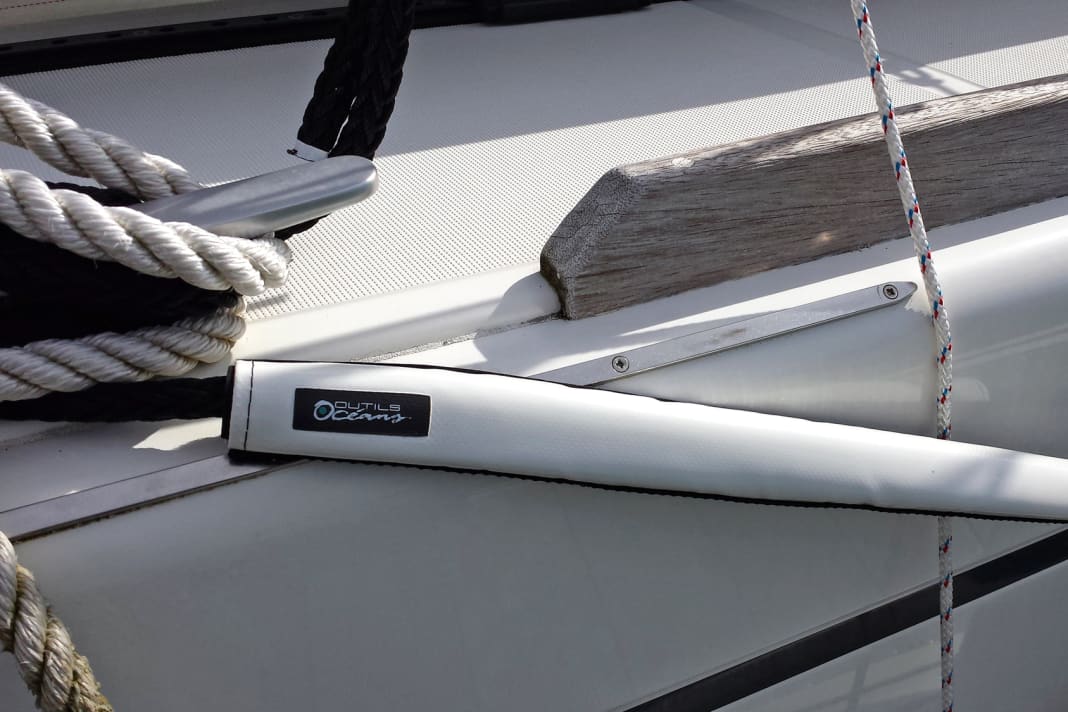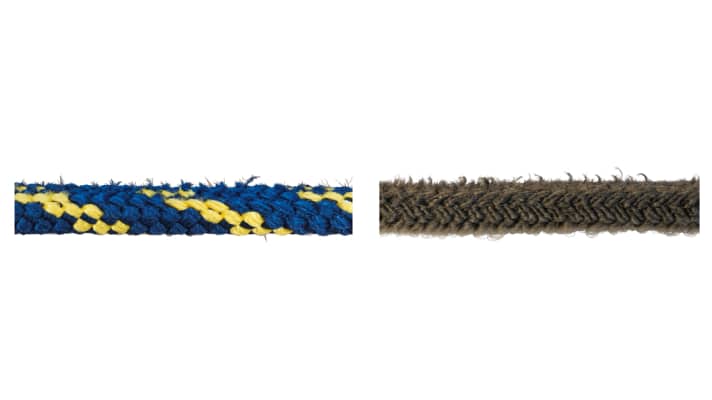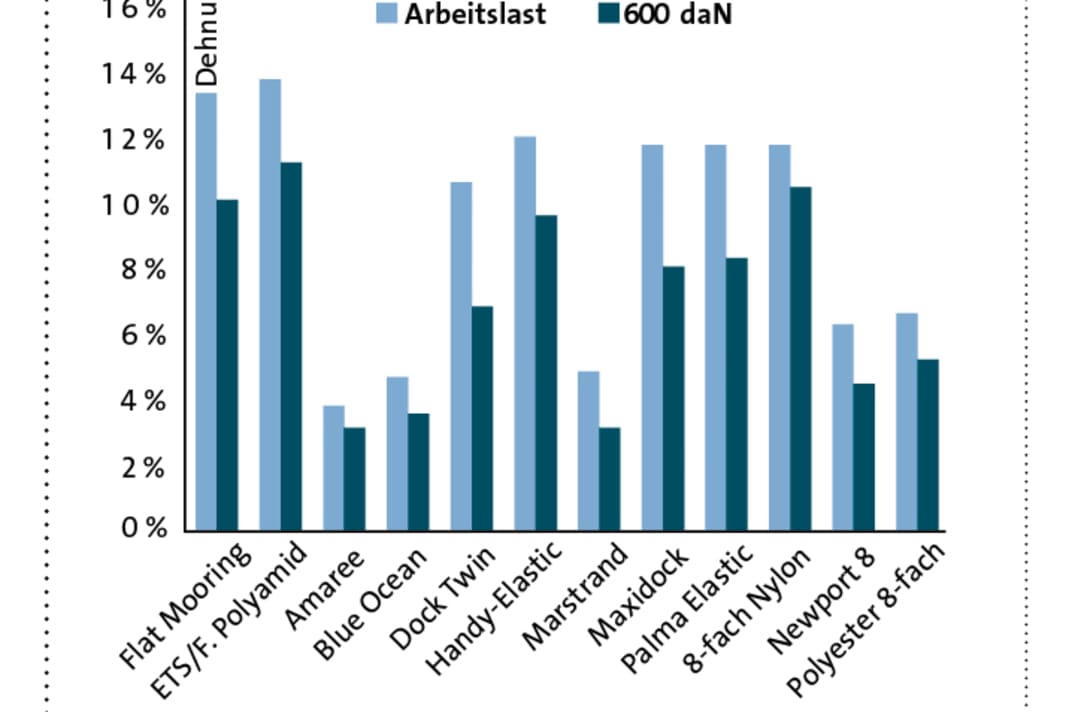
Although they are used practically every day, the mooring lines are easily forgotten. This may be because the crew is only concerned with them briefly when mooring and casting off. While a restlessly running engine is a constant reminder, the mooring lines at the bow and stern work and age almost under the radar.
The fate of the yacht depends on the lines for around a third of the year. In a typical Northern European season, the ship is moored for around 160 days. Often without supervision, as the owner is usually only on board on holiday or at weekends. Our last mooring test (BOOTE 5/2010) has already shown that a certain carelessness can have unpleasant consequences. Above all, the enormous breaking load loss of the chafed lines was a reminder to replace them in good time. In the meantime, almost all manufacturers represented in Germany have brought new lines onto the market. An inspection revealed eleven new products from Gleistein, Lancelin, Maffioli, Marlow and Robline/Teufelberger, including six core-sheath constructions, two hollow braids and three squarelines. As a reference, we have added the tried-and-tested Handy-Elastic from Liros, also a core-sheath construction, which scored well in the last test.
What the leash has to do
First and foremost, the rope must have sufficient strength to keep the boat securely moored even in strong winds. It should also offer as much stretch as possible. The more energy a line can absorb by changing its length, the softer the boat jerks in the swell, which reduces the load on the cleats and makes the stay on board more comfortable. However, none of this will help if the cordage lets go of its fibres the first time it comes into contact with a rusty iron ring, a cleat or the concrete quay. Abrasion resistance is therefore also a decisive factor. Here in particular, we were keen to see the results of the new products. In the last test, dramatic losses in breaking load occurred even with moderate wear.
The leash should also be as supple as possible, as it should be easy to cover and uncover. Kinking is also undesirable. Slip lines that do not run out cleanly can quickly put the crew in trouble in strong crosswinds. In order to fulfil these requirements as well as possible, manufacturers have been working for years on the combination of rope construction and material. In principle, two plastics are suitable for mooring lines: polyester and polyamide, also known under the brand name nylon, are the most suitable materials. Polypropylene, which is also available, is very cheap but is also much more sensitive to light and abrasion. It therefore ages very quickly and becomes hard, which is why we have not included polypropylene cordage. It should only be used as a boat mooring line if the line absolutely has to be buoyant.
We based the diameters on a virtual, ten metre long test boat. A minimum breaking load of 3000 decanewtons was required, resulting in 14 millimetre thick lines. Only the Flat Mooring from Robline did not meet this specification according to the catalogue, but was nevertheless supplied in 14 millimetres. And rightly so - in the test, we determined an average breaking load of around 4600 decanewtons, a good 60 per cent above the manufacturer's specification and more than sufficient.
Pleasingly, none of the lines undercut the manufacturer's specification by more than 18 per cent, and as a rule the ropes were even able to withstand significantly higher forces. The largest downward deviation occurred with the ETS from Lancelin. However, with its 4077 decanewtons, the line is still very suitable for the test boat. The Maxidock from Maffioli lives up to its name: with more than 5600 decanewtons, it has the highest breaking load in the test.
Tips against chafing to click through:




In practice, the breaking load of a mooring line only plays an indirect role; the working load is derived from it. According to the recommendations of the classification society DNV GL, it should not exceed 20 per cent of the breaking load, which corresponds to values between 735 and 1128 decanewtons for the test candidates. Higher working loads offer scope for mechanical damage to the rope.
To test the abrasion resistance, we abraded all the lines under exactly the same conditions as the last test and then determined the breaking load of the damaged rope. After the test, the polyester squareline from Lancelin showed the least damage, with just under 60 per cent of the original strength remaining. The worst performers were the Handy-Elastic from Liros and the Dock Twin from Gleistein, which lost 60 and 55 per cent of their breaking load respectively. Only the Maxidock from Maffioli still achieved the required breaking load or working load for our test boat after the abrasion test. The line only lost 44 per cent of its strength and still had the necessary reserves thanks to its high breaking load.
The choice of material, i.e. polyester or polyamide, plays practically no role in the abrasion resistance of the line; both plastics are roughly on a par. And there is also no clear picture when it comes to construction. Core-sheath braids, hollow braids and squarelines sometimes perform better, sometimes worse, depending on the manufacturer. However, one thing is particularly striking: the appearance is deceptive. The Handy-Elastic from Liros, which at first glance appears almost undamaged, lost 60 percent of its breaking load, so a lot of fibres must have been damaged, while the visually significantly impaired Maxidock only lost 44 percent.
The material decides
Ropes made of polyamide have a clear advantage in the elongation measurement, offering up to three times more stretch than polyester ropes (see below). These differences were already apparent during the testing. While the polyester ropes could be pulled to the breaking point in a single operation without any problems after the obligatory pre-tensioning, the path of the tensile testing machine was not sufficient for polyamide products - it extended so persistently that we had to interrupt every tensile test and re-tension the batches several times in some cases. The nylon squareline from Robline has the highest elongation, it stretches by around 15 per cent under working load and also achieves the best values with our comparative load of 600 decanewtons. At the other end of the scale are the Amarre from Lancelin and the Blue Ocean from Marlow with 3.8 and 4.6 per cent respectively.
The low stretch of the Blue Ocean is due to the material; it is a rope made from recycled PET, i.e. polyester, which is obtained from empty drinks bottles. However, the poor performance of the Amarre is surprising. Its core is made of polyamide, so the rope should actually stretch a lot. Apparently, the relatively compact polyester sheath limits the stretch, which makes the rope behave like a pure polyester product.
If you have such lines on board, you have to reckon with hard jerks in swell. In any case, we recommend retrofitting shock absorbers.
Of course, both would be ideal, a stretchable rope and an additional rubber buffer in rough harbours. The elongation values make polyamide rope the predestined mooring line, but this is countered by another material property: polyamide absorbs water, with the result that the fibres shrink. In practice, this means that The lines can become stiff and unwieldy after a short time. Whipped ropes harden particularly quickly; core-sheath braids and squarelines, on the other hand, are much less critical. Modern polyamide ropes therefore retain their suppleness for many years.
To accelerate the ageing process, we stored the polyamide samples in a 65-degree water bath for five days. This stress test made the lines slightly stiffer; no significant differences between the products could be identified.
Convenient handling
The hollow braids and squarelines nestle best around cleats and bollards. However, they also tend to pull individual fibres out of the construction on rough surfaces. The flat mooring and the long braided squareline from Lancelin seem particularly susceptible. The core-sheath constructions also feel good in the hand and are easy to shoot. Only the Amarre from Lancelin is a little less supple and tends to form kinks. In terms of spliceability, there are basically only design-related differences. Hollow braids are the easiest to work with. Some practice is required to keep track of the square lines, only core-sheath constructions require more effort. In order to maintain the breaking load, both the core and the cover must be spliced together.
No question of price
If you remember how long the ship hangs unattended on the mooring lines, it becomes clear that no compromises should be made when deciding on ropes. The outstanding stretch makes polyamide lines the first choice. They not only ensure relaxed nights on board, but also protect the fittings. As a rule, they offer higher breaking loads, which provides greater safety reserves in the event of damage. If they harden after a few years, it is better to replace them. Polyester ropes, on the other hand, remain supple, but are also low-stretch and therefore less suitable. Considering the enormous loss of strength associated with damage to the lines, the mooring lines should also be replaced immediately in the event of any recognisable damage.
With very good elongation and good wear resistance, the nylon squareline from Robline secured the test victory, closely followed by the Maxidock from Maffioli as the best core-sheath braid. The ETS from Lancelin is also in the top three; as it is one of the cheapest lines, it also receives the price-performance tip. However, if you go for the Dock Twin, the Handy Elastic or the Palma Elastic, you won't make a bad choice either.
The polyester anchors perform worse across the board. The Squareline from Lancelin performs best. The Blue Ocean can at best score points with its environmental aspect.
This is how we tested





Elongation, breaking load, abrasion resistance and handling can be objectively and reproducibly assessed in the laboratory
We were able to occupy the Liros test laboratory for a good three days to test the mooring lines. Measuring elongation is particularly time-consuming, as every rope has what is known as constructional elongation in addition to the material-dependent stretch - a line fresh from the braiding machine behaves differently to a line that has already been stretched several times. We therefore pre-stretched all the mooring lines before determining the elongation. A total of 84 tensile tests were necessary. We selected the number of abrasion cycles in preliminary tests so that no line was completely destroyed. After this ordeal, the breaking load of the damaged rope was determined on the tensile testing machine.
Is it still good?

Unfortunately, the condition of a damaged mooring line cannot be reliably assessed by visual inspection
Every skipper has experienced this: after a restless night, you can see signs of rubbing on the mooring lines - but changing the line just because of a few fluffs? It doesn't look that bad. The breaking load test shows just how wrong this assessment can be. As usual, we first visually inspected the damaged lines after the abrasion test and sorted them according to the visible damage. The clear winner was the Handy-Elastic, which appeared to have very few damaged fibres. In contrast, the Dock Twin, Maxidock and Palma Elastic did not look very trustworthy. In fact, however, they had all lost less strength.
Test results



Give in or give up?





